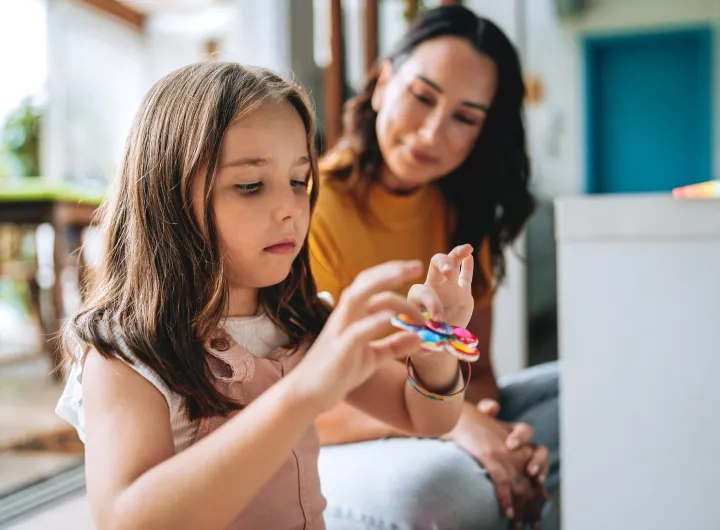Parenting autistic kids: 5 practical tips to support you and your child

Parenting and caring for children on the autism spectrum* can be filled with mixed emotions. It can bring joy, frustration, compassion and sorrow, sometimes all on the same day.
While raising a child with autism can be challenging, it can also offer new ways of seeing the world.
You might be wondering what you can do to help your autistic child, or how to parent a child with autism best. That’s where positive parenting can help. It’s not a magic fix, but it offers tools to help you handle difficult moments, feel more confident, respond calmly and value the uniqueness of your child. It can also help you look after your mental health as you navigate the different therapies and advocacy involved with raising a child with autism.
What is autism? Understanding your autistic child
Autism Spectrum Disorder (ASD) is a neurodevelopmental disorder most likely caused by a combination of genetic, biological and environmental factors.1 It is characterised by difficulties with social interactions and communication, limited interests and repetitive behaviours. Although autism presents differently in every child, the first signs typically occur before age three.
Autism is divided into three levels of severity. These levels determine the type and intensity of supports that will be offered to affected children to support their engagement with schools, their community and daily life. Level 1 requires the lowest amount of support and Level 3 requires the highest. No matter what level your child is at, help is available.
Here are five practical tips backed by research for parents and carers of children with autism.
Tip 1. Play and have fun together
Many parents and carers report feeling overwhelmed2 raising a child diagnosed with ASD. You might be wondering how to connect with your autistic toddler, or what to do when they flap their hands, stim, spin around or toe walk. With so much on your mind, it can be easy to forget to slow down and do what matters most.
By spending time with your child doing what they love, you can both find joy in everyday moments. Maybe it’s listening to them talk about Pokémon characters? Or lining up toy cars together? Perhaps building block towers and knocking them down over and over again?
By giving your attention to your child’s interests, you’ll be building a positive relationship that will help strengthen your bond. It will also give you opportunities to help them learn to play interactively with you and gradually extend their range of interests to other activities.
Tip 2. Create routines that support independence
Many children on the autism spectrum thrive on structure. Routines can make daily life feel calmer and reduce stress for parents, carers and children alike.
For example, a dinner routine might include washing hands, sitting at the table, eating and putting the plate away. Eventually this could become part of a larger routine, such as playtime, dinner, bath and bed. Try creating a visual schedule or chart listing each of the steps to show your child what comes next. Some kids prefer more detail than others, so see what works best for your child. You can also use a visual schedule like this to help kids understand and adjust to changes in the routine. For example, if the routine changes and instead of ‘dinner’ you are ‘going out’, you can change the picture on the schedule and explain to your child what is going to be different.
A first-then approach – such as “first teeth, then story” – can also make transitions easier. Start small and build on what works. Helping your child know what to expect builds trust, confidence and independence.
Tip 3. Use encouragement to build new skills
When you praise your autistic child for doing something well, this encourages them to do it more often.
Be specific. Say what you liked, such as “I love how you packed away your toys” or “thanks for tidying your bedroom.” You could also praise effort, such as “you tried so hard to put your shoes on by yourself – well done.” Exaggerate your non-verbal expressions when you praise them by looking really pleased, smiling and using other signals that suggest happiness in your family, like clapping your hands.
Small activity rewards, such as a trip to the playground after getting chores done or playing their favourite boardgame after a successful shopping trip, can also help build your autistic child’s confidence and make learning feel more enjoyable and fun.
Tip 4. Try to stay calm and consistent
Challenging behaviours and meltdowns can be upsetting, especially when it happens often or feels unpredictable. It can be hard working out how to help a child with autism calm themselves and how to respond in these moments. No one is perfect and you're not always going to nail it, especially if you have a lot going on.
Think about how you would like your child to manage big feelings and how you can teach them to use the skills they will need at times when there are no problems. You could teach them to recognise and label feelings, to take some slow breaths in and out, to ask for a break when doing things, or to go to a quiet place and calm down on their own. You could also think about teaching these skills by showing them, practising together, or playing pretend games involving doing these things.
When you are feeling challenged, start by taking deeps breaths and pausing for a few seconds. When you stay calm it helps your autistic child feel safe.
When meltdowns occur, choose one or two simple responses that work and stick with them. For example, you might say, “I can see you're really upset, we need to take a break now.” Over time, you can prompt your child to recognise when they are getting upset or over-stimulated and to ask for a short break. If your autistic child shows aggressive behaviour, like throwing something or hitting, you might move them to a quiet space and say, “that’s not okay, we’re taking a break so we can both calm down.”
Being consistent helps your child know what to expect. Setting limits helps them develop self-control. These simple steps go a long way in helping you guide your autistic child’s behaviour and create a safe and loving environment.
Tip 5. Teach everyday skills step-by-step
Learning new skills can be overwhelming for an autistic child, especially when they involve changes to a routine. Breaking complex activities down into a few simple steps can make a world of difference.
One strategy useful for teaching new skills is “teaching backwards”. Initially, this involves helping your autistic child through all the steps of a skill except the last. For the final step, the parent might back off and allow the child to complete it on their own. The next time the parent might encourage the child to do the last step, as well as the second last step, on their own. Gradually, the parent works backwards through the steps with the child, who does more and more without their parent’s help. The goal is to gradually reduce your help one step at a time until your child can complete the task from the beginning, all on their own.
For example, putting on a t-shirt can be broken down into:
- Put one arm through the sleeve
- Put the other arm through the sleeve
- Pull the shirt over your head
- Pull the shirt down over your tummy (the final step)
Offer lots of encouragement and praise along the way and remember to celebrate the small wins.
Want more support and tips?
Stepping Stones Triple P is an evidence-based parenting program designed for parents or carers of children with developmental disability and/or additional needs and is suitable for neurodivergent children.
Whether you're looking for parenting resources, tips for raising an autistic kid or more comprehensive support that really works, this flexible online course offers real-life strategies you can start using straight away.
*Please note: For the purposes of this article, the terms autism, ASD, autistic, child with autism and autistic child are used interchangeably to acknowledge terms used by families, individuals and organisations and to respect the right of everyone with lived experience to use the language they prefer.
References
- American Psychiatric Association. (2013). Diagnostic and statistical manual of mental disorders (5th ed.). https://doi.org/10.1176/appi.books.9780890425596
- Dharanidharan, D., Kuruveettissery, S. Parental Perspectives on Stress and Challenges in Raising Autistic Children: A Meta-Synthesis. J. Psychosoc. Rehabil. Ment. Health 12, 125–141 (2025). https://doi.org/10.1007/s40737-024-00420-4

